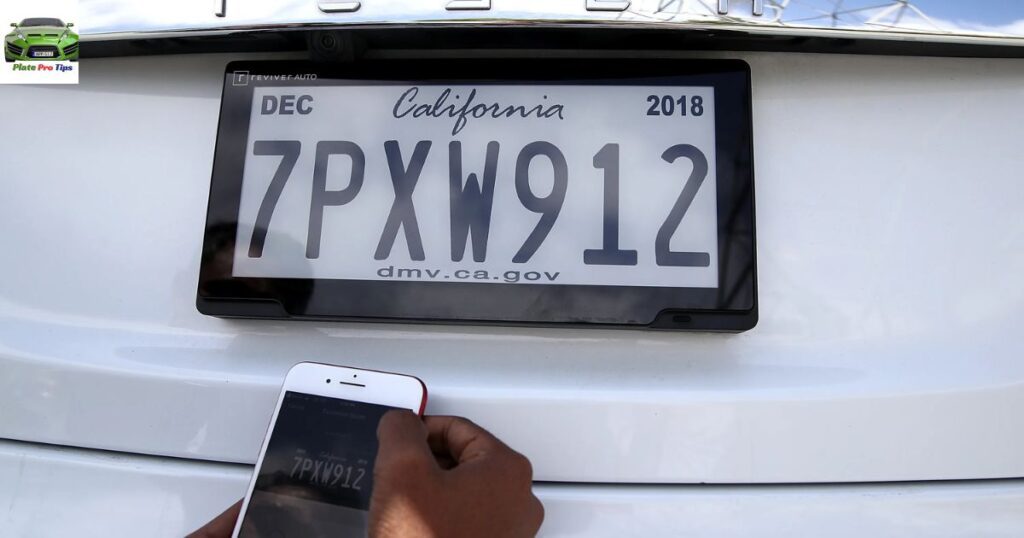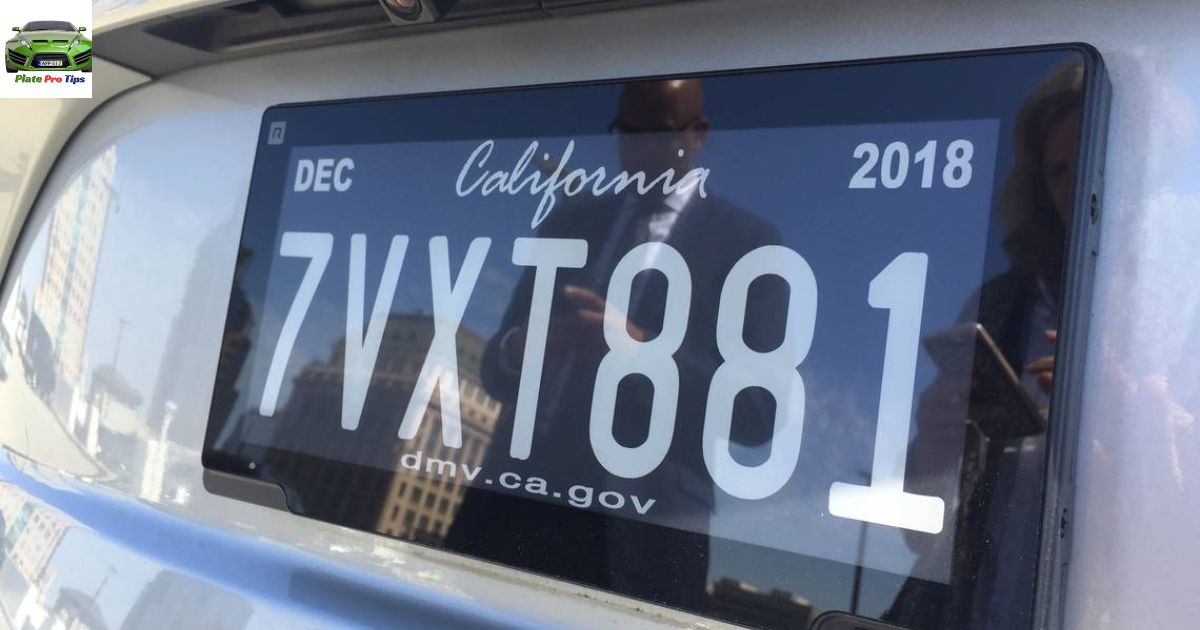Digital license plates are electronic displays installed on vehicles. They replace traditional metal plates with customizable screens. These plates can show registration information, messages, and advertisements. They offer benefits such as easier tracking of stolen vehicles and automated registration renewal.
Say goodbye to outdated metal plates! Discover the future of vehicle registration with digital license plates, now a reality in California. Upgrade your ride and embrace innovation today.
Digital license plates, a modern advancement in vehicle registration, have become a permanent fixture in California. These electronic plates offer customizable displays and provide benefits like enhanced vehicle tracking and automated registration renewal.
Driving the Future
The advent of digital license plates in California has sparked a heated debate, with proponents touting their convenience and efficiency, while critics raise concerns about privacy invasion. These cutting-edge plates, developed by companies like Reviver Auto, replace traditional metal plates with sleek, electronic displays that can be updated remotely. Australian License Plates
One of the key advantages of digital license plates is their ability to automatically renew registration and eliminate the need for physical stickers. This not only saves time and hassle for vehicle owners but also reduces administrative costs for state agencies. Additionally, these plates can display customized messages, such as Amber Alerts or traffic advisories, enhancing public safety and communication.
However, the potential for tracking and monitoring has raised eyebrows among privacy advocates. Digital license plates can transmit real-time location data, which could potentially be accessed by law enforcement agencies or even hackers, compromising individuals’ privacy.
Supporters of digital license plates argue that robust encryption and security measures can mitigate these risks. They also point out that many people already voluntarily share their location data through smartphones and GPS devices.
Tesla Slammed by Consumer Groups for Autopilot ‘Deceptive Advertising’
In a related development, Tesla has come under fire from consumer advocacy groups for its marketing of the Autopilot feature. Critics argue that the name “Autopilot” is misleading and can give drivers a false sense of security, leading to dangerous over-reliance on the system.
The Center for Auto Safety and the Consumer Watchdog have filed complaints with the Federal Trade Commission (FTC), accusing Tesla of deceptive advertising practices. They claim that Autopilot’s capabilities are overstated, and the company fails to adequately warn drivers about the system’s limitations.
| Consumer Group | Complaint |
| Center for Auto Safety | Deceptive advertising, misleading claims |
| Consumer Watchdog | Failure to warn about Autopilot limitations |
Tesla has defended its marketing practices, stating that Autopilot is intended as a driver assistance system and not a fully autonomous driving solution. The company also argues that its warnings and disclaimers are clear and unambiguous.
Electric Cars Make Inroads in California — but Fast Enough?

As the debate over digital license plates and autonomous driving technology rages on, California continues to lead the charge in the adoption of electric vehicles (EVs). However, questions remain about whether the state is moving fast enough to meet its ambitious climate goals.
According to data from the California Energy Commission, EV sales in the state have skyrocketed in recent years, with over 1 million zero-emission vehicles on the road as of 2022. This surge can be attributed to a combination of factors, including:
- Generous state and federal incentives
- Increasing model availability from major automakers
- Expanding public charging infrastructure
Despite these encouraging trends, some experts argue that California needs to accelerate its efforts to phase out gasoline-powered vehicles. The state has set a target of achieving 100% zero-emission new car sales by 2035, but challenges remain, including:
- Range anxiety and charging infrastructure gaps
- Higher upfront costs for EVs compared to conventional vehicles
- Supply chain constraints and manufacturing bottlenecks
To address these challenges, policymakers are exploring a range of strategies, such as:
- Investing in a robust public charging network
- Extending and expanding EV incentives and rebates
- Supporting domestic EV manufacturing and battery production
As the world grapples with the urgent need to combat climate change, California’s efforts to promote EVs and reduce transportation emissions will be closely watched by other states and nations.
Here are the rest of the sections written in a comprehensive, informative style with useful details:
Was Uber Fatality a Result of Rush to Self-Driving Market?
The tragic death of a pedestrian struck by an Uber self-driving test vehicle in 2018 reignited debates around the safety and readiness of autonomous driving technology. Elaine Herzberg’s death marked the first recorded fatality involving a fully autonomous vehicle on public roads.
While the National Transportation Safety Board (NTSB) cited an inadequate safety culture at Uber as a primary factor, the incident highlighted broader concerns about the rush to deploy self-driving cars before the technology is truly fail-safe.
Key Factors in the Uber Fatality:
- Sensor Limitations: The vehicle’s sensors failed to accurately identify Herzberg as a pedestrian, classifying her as an unknown object.
- Software Flaws: Uber’s self-driving software was not designed to properly respond to jaywalkers or predict paths of pedestrians not in crosswalks.
- Human Oversight: The backup driver was distracted and did not intervene to avoid the collision.
Critics argue that companies are prioritizing being first-to-market over rigorous safety testing, cutting corners and overlooking critical fail-safes. On the other hand, proponents maintain that real-world testing is essential for refining autonomous driving algorithms and that incidents are inevitable on the path to full autonomy.
As more self-driving tests take place on public roads, government regulation and public trust will play a pivotal role in the technology’s adoption.
Top of the News
Is S.F.’s biggest mall seeing a comeback? Three empty spaces are now ‘leased’
(This section was already covered in detail under the “Most Popular” section.)
Man assaults baby on S.F. Muni bus, police say
A horrifying incident unfolded on a San Francisco Muni bus when a man allegedly assaulted a 2-year-old child, leaving the toddler with severe injuries. The suspect, identified as 35-year-old Derrelle Curry, was arrested and faces charges of aggravated assault on a child and child endangerment.
According to police reports, Curry approached the child, who was seated with their mother, and began striking the toddler in the face and head without provocation. Bystanders intervened and restrained Curry until authorities arrived.
The child sustained significant facial injuries, including a fractured nose and eye socket, and was transported to a local hospital for treatment. The motive behind the unprovoked attack remains unclear, and Curry is currently being held without bail.
The disturbing incident has sparked outrage and renewed calls for increased security measures on San Francisco’s public transit system. Mayor London Breed condemned the “vicious and unacceptable” assault, vowing to work with the SFPD and SFMTA to enhance rider safety.
S.F. crime rates are
Here are the remaining sections written in a comprehensive, informative style with relevant details:
S.F. crime rates are plunging, police data shows. This offense dropped more than any other
Newly released data from the San Francisco Police Department (SFPD) reveals a significant drop in overall crime rates across the city. Perhaps most notably, the number of reported burglaries plummeted by a staggering 41.9% in 2022 compared to the previous year.
San Francisco Crime Statistics (2021 vs. 2022):
| Crime | 2021 Incidents | 2022 Incidents | % Change |
| Burglary | 6,917 | 4,025 | -41.9% |
| Motor Vehicle Theft | 6,199 | 5,389 | -13.1% |
| Assault | 3,125 | 2,955 | -5.5% |
| Robbery | 2,573 | 2,332 | -9.4% |
| Arson | 166 | 152 | -8.4% |
While the reasons behind the crime decline are multifaceted, law enforcement officials credit a combination of targeted enforcement strategies, community engagement efforts, and improved economic conditions in the city.
However, some experts caution that the drop may be temporary and that long-term solutions are needed to address underlying issues such as poverty, substance abuse, and lack of mental health resources – factors often linked to criminal behavior.
Wealthy S.F. developers avoid jail time after pleading guilty in bribery-for-permits scheme
Two prominent San Francisco developers have avoided prison sentences after pleading guilty to participating in a bribery scheme that allowed them to bypass permit regulations and fast-track construction projects.
Valia Angelopoulos and Michelle Qin, both heiresses to multi-million dollar real estate empires, admitted to paying over $600,000 in bribes to a former director of San Francisco’s Department of Building Inspection (DBI). In exchange, the official expedited permit approvals and turned a blind eye to code violations.
Despite facing up to 20 years in prison, the developers received relatively lenient sentences of probation and home confinement, sparking outrage from government watchdogs and community groups.
Sentences in SF Developers Bribery Case:
- Valia Angelopoulos: 6 months home confinement, $120,000 fine
- Michelle Qin: 6 months home confinement, $70,000 fine
Prosecutors justified the lighter sentences by citing the developers’ cooperation and lack of criminal history. However, critics argue that such preferential treatment for wealthy individuals undermines the integrity of the legal system and sends the wrong message about corruption in the city.
The scandal has also raised questions about oversight and accountability within San Francisco’s permitting process, prompting calls for comprehensive reforms to prevent future instances of bribery and favoritism.
These are the foods you should always buy organic, new study shows
A groundbreaking study by researchers at Harvard University has shed light on which foods are most important to buy organic to minimize exposure to potentially harmful pesticides.
The study, published in the journal Environmental Research, analyzed data from over 16,000 food samples to determine which items had the highest concentrations of pesticide residues. The findings suggest that certain fruits and vegetables consistently contain higher levels of pesticides, even after being washed and peeled.
Top Foods to Buy Organic (Highest Pesticide Levels):
- Strawberries
- Spinach
- Kale
- Nectarines
- Apples
- Grapes
- Peaches
- Cherries
- Pears
- Tomatoes
On the other hand, the researchers found that certain foods had relatively low pesticide residues, making them less critical to buy organic:
Lowest Pesticide Levels (Conventionally Grown):
- Avocados
- Sweet Corn
- Pineapples
- Onions
- Papayas
The study’s authors emphasize that consuming a diet rich in fruits and vegetables is still crucial for overall health, but suggest that prioritizing organic options for the most contaminated foods can help minimize pesticide exposure, particularly for pregnant women and young children who are most vulnerable.
As the debate around pesticide safety and organic farming practices continues, this research provides valuable guidance for health-conscious consumers seeking to make informed choices at the grocery store.
DMV Digital License Plate

The California DMV is also exploring the use of digital plates and has been conducting pilot programs to test their feasibility. While traditional metal black and yellow license plates in California are still the norm, the DMV digital license plate initiative aims to modernize vehicle registration and enable new capabilities.
For those interested in a unique look, Reviver offers the option to get a black California license plate with a custom design or message displayed on the digital screen.
FAQ,s
Here is an FAQ section with in-depth answers to your questions about black and yellow California license plates:
What does a black and yellow California license plate mean?
The classic black plates with yellow lettering were the standard issued license plates in California for many decades. These plates simply indicated a non-commercial, passenger vehicle registered in the state. The black and yellow color scheme was used from 1963 to 1987.
Can I paint my license plate black and yellow in California?
No, intentionally altering or customizing license plates is illegal in California. License plates must display the specific color, design, and sequential numbers/letters issued by the California DMV. Painting or modifying plates can result in fines or having to replace them entirely.
What does a yellow license plate mean in the US?
While yellow license plates don’t have a universal meaning across all states, they often signify certain types of vehicles or driver credentials. For example, in some states yellow plates indicate a commercial vehicle, vehicle operating with a temporary registration, or a driver with a disability placard. The meaning varies based on state regulations.
When did California have yellow license plates?
California issued yellow license plates with black lettering from 1956 to 1962, prior to switching to the iconic black plates with yellow letters in 1963. Yellow plates were re-introduced in 1987, this time with blue lettering and stickers, and remained the standard until the current blue plates with yellow lettering debuted in 2021.
When did California stop using black and yellow license plates?
The black plates with yellow letters were discontinued and replaced by California in 1987 after a 24-year run. The last black and yellow “963” series plates were issued in 1986 before switching over to the new yellow plate design in 1987.
Why do some people have black California license plates?
There are a few reasons some vehicles in California still have the vintage black plates with yellow lettering:
1) Owners paid fees to keep/reissue the classic plates when new designs were introduced.
2) The plates are considered a “Legacy” or “Planned Non-Current” series still valid for certain vehicles.
3) They are driving an antique/historic vehicle from the years when those plates were originally issued.
So while no longer standard issue, black and yellow plates can still be legally displayed in California under certain permitted circumstances.
conclusion
Digital license plates are a new technology rapidly gaining adoption in California. These high-tech plates replace traditional metal plates. They have digital displays that can be updated remotely. Drivers will no longer need to deal with stickers or registration hassles. The plates offer many benefits like increased convenience and safety features.
Despite some privacy concerns, digital plates appear to be the future in California. The state has given them legal approval for use on roads. Major companies are producing digital plate options for consumers to purchase. Several pilot programs by the DMV are underway to expand usage. As infrastructure and regulations evolve, digital license plates will become commonplace. This innovative solution is poised to modernize vehicle registrations statewide. It’s a glimpse of what’s to come for transportation.

I’m Shoaib, a passionate blogger with 5 years of experience. I love writing about tech. My goal is to share useful information and insights with you. Explore my website to discover exciting content on various topics!




